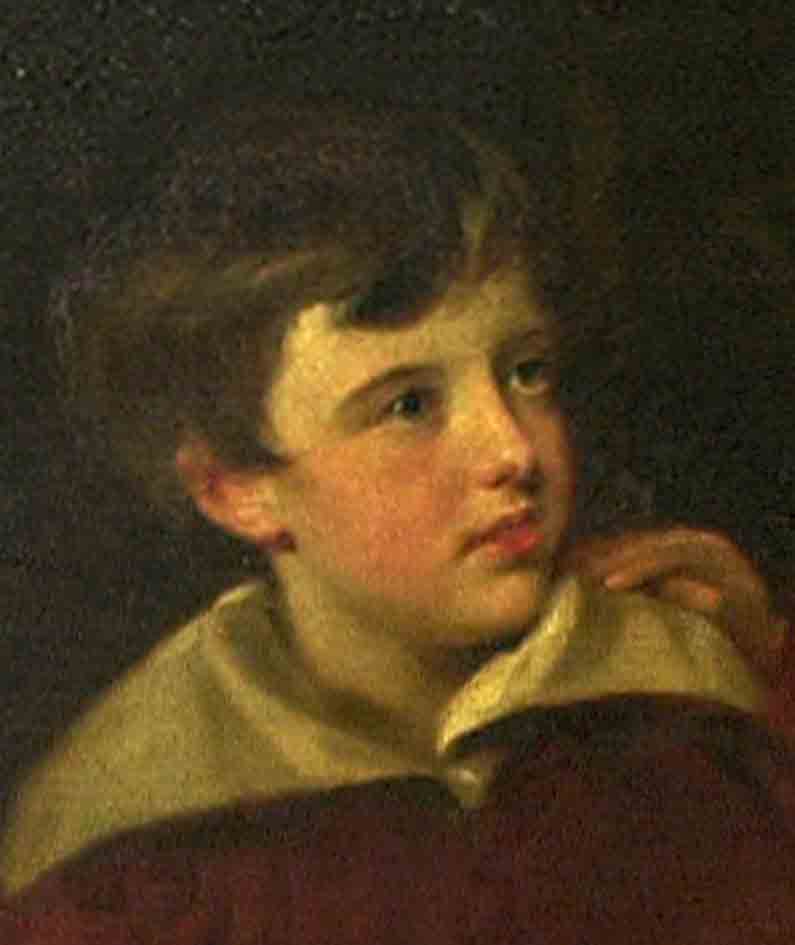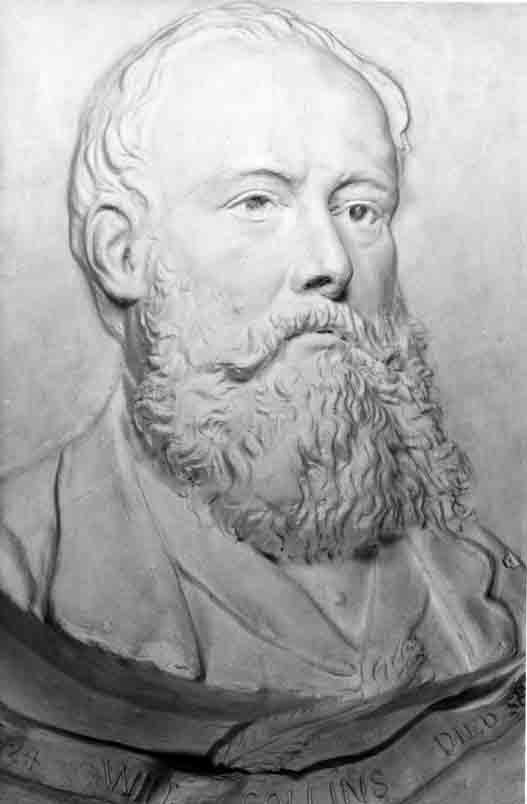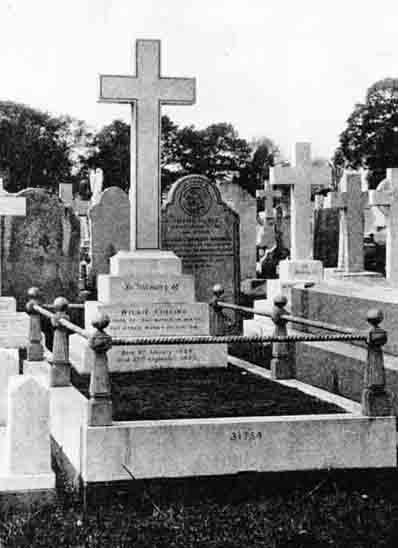Wilkie Collins - A Short Biography
[ Introduction ] [ The Early Years ] [The Dickens Connection ] [The Woman in White and success ]
[ The Other Woman ] [The Moonstone ] [ The Final Years ]
[ Front page ]
William Wilkie Collins, or Wilkie as he was known to his friends and readers, was born in London's Marylebone where he lived more or less continuously for 65 years. Today he is best known for The Moonstone (1868), often regarded as the first true detective novel, and The Woman in White (1860), the archetypal sensation novel. During his lifetime, however, he wrote over thirty major books, well over a hundred articles, short stories and essays, and a dozen or more plays.
He lived an unconventional, Bohemian lifestyle, loved good food and wine to excess, wore flamboyant clothes, travelled abroad frequently, formed long-term relationships with two women but married neither, and took vast quantities of opium over many years to relieve the symptoms of ill health. Collins's circle of friends included many pre-eminent figures of the day. He knew the major writers, particularly Charles Dickens with whom he regularly collaborated, as well as a host of minor novelists. His friends and acquaintances included some of the foremost artists, playwrights, theatrical personalities, musicians, publishers, physicians and society figures of the time. Collins's unorthodox lifestyle reveals a cynical regard for the Victorian establishment. This view is reflected in his books together with a sense of humour and a profound understanding for many of the then prevailing social injustices.

Wilkie Collins aged 9, painted in 1833 by Andrew Geddes (1783-1844)
Wilkie Collins was the elder son of William Collins the celebrated landscape artist and portrait painter and named after his godfather, Sir David Wilkie. His childhood schooldays began in 1835 at the Maida Hill Academy, followed by a two year interruption when he accompanied his parents and younger brother, Charles, to France and Italy from September 1836 to August 1838. He later recalled that he had learned more in Italy 'which has been of use to me, among the scenery, the pictures, and the people, than I ever learned at school.' He also claimed that he had fallen in love for the first time in Rome at the age of 12 or 13. Returning to England, his schooling continued at Cole's boarding school at 39 Highbury Place. It was here that he began his career as a storyteller to appease the dormitory bully, later recalling that 'it was this brute who first awakened in me, his poor little victim, a power of which but for him I might never have been aware.' His appearance was distinctive since he was born with a prominent bulge on the right side of his forehead. He was only five feet six inches tall but with a disproportionately large head and shoulders. His hands and feet were particularly small and pictures from the age of 21 show him wearing spectacles.
Wilkie left school in 1841 and was apprenticed to the tea merchants Antrobus & Co. in the Strand. It was here, in what he called 'the prison on the Strand' that he began his writing with his first signed publication, 'The Last Stage Coachman' appearing in Douglas Jerrold's Illuminated Magazine in August 1843. From May 1846 Collins became a law student at Lincoln's Inn and was called to the bar in 1851. He never practised his profession although several lawyers feature prominently in his subsequent novels. His father died in 1847 and his first published book, The Memoirs of the Life of William Collins, Esq., R.A., appeared the following year and received good reviews. It was followed by an historical novel, Antonina (1850) and three contemporary novels, Basil (1852), Hide and Seek (1854) and The Dead Secret (1857).
During the 1850s, however, Wilkie's main income was derived from journalism with numerous contributions to Bentley's Miscellany, The Leader and more particularly Dickens's Household Words. He had first met Dickens in 1851 through the introduction of Augustus Egg. Collins, always keen on amateur theatricals, needed little persuasion to join the great man's company for his production of Bulwer-Lyttons's Not so Bad as We Seem, written to raise money for the Guild of Literature and Art. A firm friendship developed between the two writers which lasted until Dickens's death in 1870. They frequently travelled together on the Continent to France and Italy and Wilkie became a frequent visitor to Dickens's homes at Tavistock House and Gad's Hill where he was encouraged to fulfil his theatrical ambitions. Collins wrote The Lighthouse in 1855 and The Frozen Deep in 1856. Both were originally produced by Dickens and his company but were subsequently performed on the professional stage. Collins first contribution to Household Words in 1852, 'A Terribly Strange Bed' is still published in modern anthologies of 'terror and the supernatural'. He joined the permanent staff of the magazine in November 1856 at a weekly salary of 5 guineas. Altogether he wrote more than 50 stories and articles many of which were republished in After Dark (1856), The Queen of Hearts (1859) and My Miscellanies (1863). Dickens's correspondence frequently mentions Collins's industry and dependability and they collaborated on several of the Christmas numbers.
Despite his growing success, Collins's health began to decline during the 1850s and 1860s, suffering from what he always described as 'rheumatic gout' or 'neuralgia'. These affected his eyes with particular severity and he often needed the services of a secretary - provided either by Frank Beard, his doctor and lifelong friend, or Carrie Graves. He visited numerous physicians and tried various remedies including Turkish and electric baths, Health spas, hypnotism and quinine. Ultimately Beard prescribed opium in the form of laudanum as a pain-killer and sedative, but always for purely medical reasons. Over the years Collins developed an enormous tolerance and eventually took daily 'more laudanum than would have sufficed to kill a ship's crew or company of soldiers.
The Woman in White and Success
It was during the 1860s that Collins achieved enduring fame with his four major novels, The Woman in White (1860), No Name (1862), Armadale (1866) and The Moonstone (1868). The first of these was published in Dickens new journal, All the Year Round from November 1859 to August 1860. It was received with great popular acclaim and ran to seven editions in 1860, alone. All kinds of commodities such as cloaks, bonnets, perfumes were called after it; there were Woman in White Waltzes and Quadrilles; it was parodied in Punch; Gladstone found the story so absorbing that he missed a visit to the theatre; and Thackeray was engrossed from morning to sunset.
The sudden meeting in the novel of the hero, Walter Hartright, with the mysterious woman in white is said to have been inspired by a real life meeting between Collins, strolling home one evening in 1858, accompanied by his brother Charles and the painter Millais. They were accosted, so the story runs, by 'a woman dressed in flowing white robes escaping from a villa in Regent's Park where she had been kept prisoner under mesmeric influence. ' The real life woman in white was Caroline Graves who probably met Wilkie in the spring of 1856. She was a widow, originally came from Gloucestershire, and had a young daughter, Harriet Elizabeth (usually known as Carrie). Caroline and Wilkie never married but lived together from about 1858 for the best part of 30 years.
Whether Martha's arrival caused the temporary rift between Wilkie and
Caroline, or whether she simply gave him an ultimatum over marriage is
uncertain, but in October 1868 Caroline suddenly married one Joseph Clow. Carrie
and Frank Beard were the witnesses while Collins was himself present at the
ceremony in Marylebone Parish Church. By April 1871, however, Caroline had
returned to Gloucester Place and continued to live with Wilkie until his death
in 1889. She died in 1895 and is buried in the same grave in Kensal Green
Cemetery About 1864, however, Wilkie met the other woman in his life, Martha Rudd,
possibly in Great Yarmouth near her home in Winterton, or perhaps in London
where she may have come to work as a maid in his mother's house. Wilkie had
turned 40 while Martha was just 19. By 1868 she was installed by Collins at 33
Bolsover Street within walking distance of his other, more impressive household
at 90 Gloucester Place (now renumbered 65). To give their liaison a degree of
respectability, for they also never married, Wilkie and Martha assumed the
identities of Mr and Mrs William Dawson, the name given to their three children,
Marian, Harriet and Charley.
The Moonstone and Other Major Works
T. S. Eliot described The Moonstone as the first and greatest of English detective novels'. It is certainly a landmark in the history of crime fiction and has a strong claim to having established detective fiction as a genre. It influenced Collins's successors from Trollope and Conan Doyle onwards and has set the standard by which other detective novels are judged. During its serialisation in All the Year Round there were crowds of anxious readers outside the publishers' offices in Wellington Street waiting for the next instalment. Like The Woman in White, it has never been out of print.
Armadale is Collins's longest novel with a complex story spanning two generations of the Armadale family. It incorporates several of his favourite themes including the supernatural, identity, murder and detection and features a beautiful red-headed female villain. No Name is the story of the heroine's attempts to regain her family fortune and represents a plea by Collins against the then prevailing laws on inheritance and illegitimacy. It may be regarded as an early attempt at the didactic novel which Collins pursued more vigorously from the 1870s when he came under the influence of Charles Reade. Swinburne regarded Man and Wife (1870), which attacked both marriage laws and the cult of athleticism, as 'the first and best' of the type, 'so brilliant in exposition of character, so dextrous in construction of incident.' The Law and the Lady (1875), featuring an early example of a female detective, protested against the Scottish not proven verdict; Jezebel's Daughter (1880), otherwise full of poisoning and melodrama, made a plea for the humane treatment of lunatics; whilst Heart and Science (1883) took up the cause against vivisection.
During the 1880s, Wilkie's always delicate health continued to decline. Breathing difficulties due to heart problems became more common and he resorted to capsules of amyl nitrate and hypo-phosphate. In January 1889 he was involved in an accident and thrown from a cab by the force of the collision. There followed a severe of attack of bronchitis. He suffered a stroke on 30 June and with further complications died on 23 September.

Bas-relief of Collins by sculptor Adolf Rost
Many of Collins's later novels do not possess the force and freshness of his earlier works. Nevertheless, he remained immensely popular with the reading public and the Chatto & Windus collected edition continued to be issued for many years after his death. Now, a century later, there has been a great revival in interest both in his enigmatic lifestyle and his unique gift as a master story-teller and constructor of labyrinthine plots. There have been two recent biographies as well as radio, television, cinema and theatrical productions. Nearly all of his works have now reappeared in the bookshops from which they had been absent for many years. Once lost in unjust obscurity and partly overshadowed by his great friend Dickens, Wilkie has returned in his own right.

Collins's grave in Kensal Green (No. 31754, Square 141, Row 1)
[ Top of Page ] [ Front Page ]